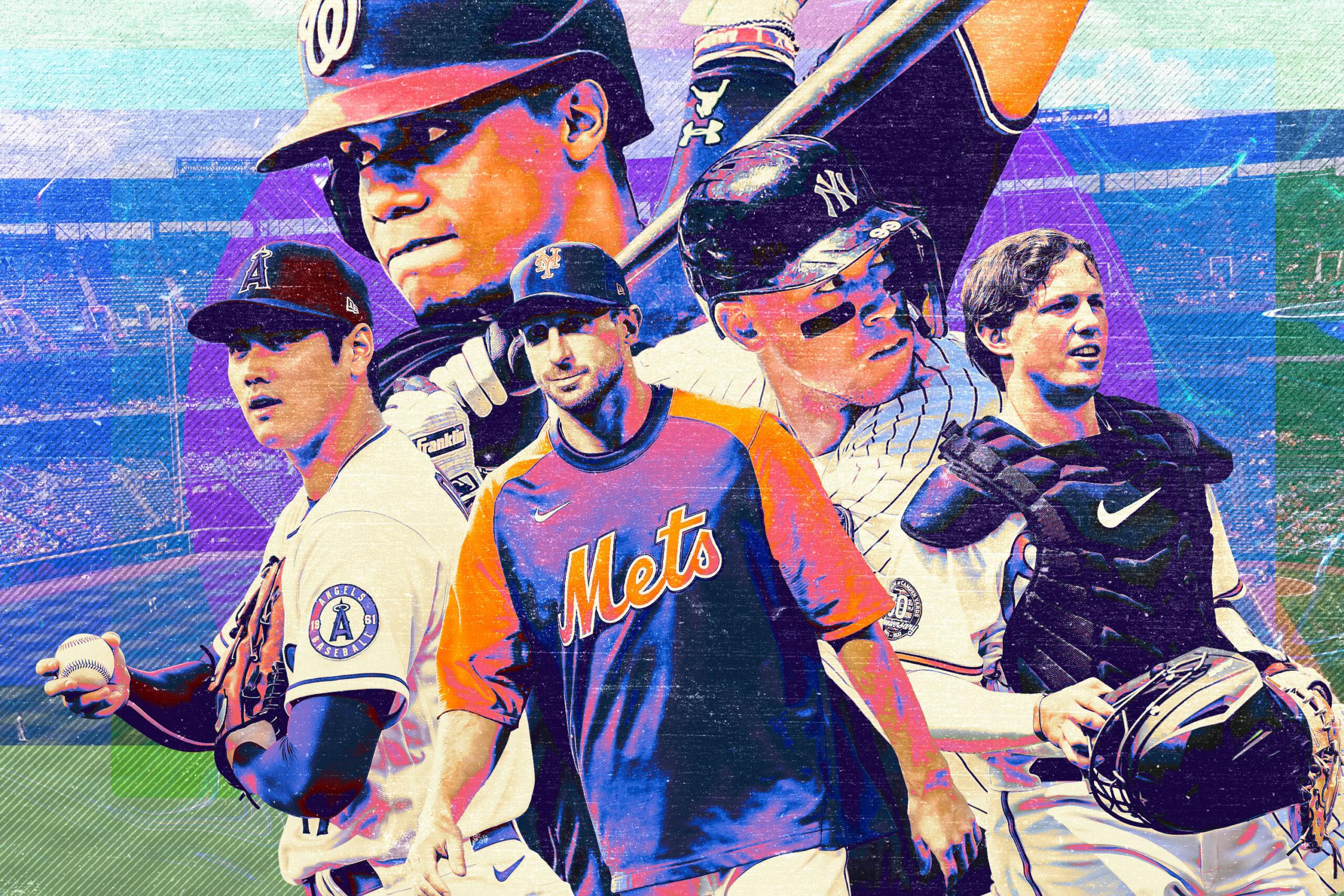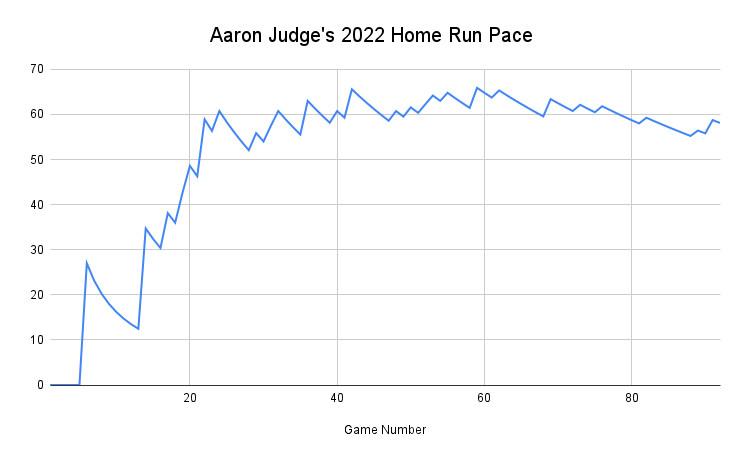
After an All-Star break festooned with nostalgia, home runs, and bullpen dominance, the MLB schedule restarts Thursday, with some 70 games remaining for each team. So before the second half begins, let’s dive into the top 10 story lines to monitor between now and October—because there’s a whole lot of baseball left, and just as much drama on the diamond.
1. Record chases in the Bronx
The first half of the season couldn’t have gone much better for the Yankees. They lead the majors in runs scored per game and runs allowed per game. They received All-Star-level campaigns from both a trio of expected candidates (Aaron Judge, Giancarlo Stanton, and Gerrit Cole) and a trio of surprises (Jose Trevino, Nestor Cortes Jr., and Clay Holmes). And they struck gold in signing Matt Carpenter, who’s bashed 13 homers and slashed an absolutely unfathomable .354/.469/.911 in 31 games.
Even in a competitive division—with all teams sitting at .500 or better—the Yankees built a 13-game lead. The question now isn’t whether they will win their first AL East title since 2019, and just their second since 2012. (FanGraphs projects that they have a 99 percent chance of doing so.) It’s whether they’ll challenge the all-time MLB record of 116 wins in a regular season. Recent weeks have demonstrated just how difficult they’ll find it to sustain their pace.
After sweeping a doubleheader against the Guardians on July 2, the Yankees were 58-21, on track for 119 wins. But a 6-7 record in the 13 games since dropped their pace to only 113 victories. They didn’t even play poorly in that span—they outscored their opponents 94-59, as four of the losses came by a single run—but they have so little margin for error to reach 116 that any minor stumble can ruin their chances.
And while the Astros, just 4.5 games back, could push the Yankees for home-field advantage, New York might not push all the way to the regular-season finish line. The team has benefitted from excellent health thus far, especially in the rotation, as its top five starters have combined to make 88 of a possible 92 starts. Now, though, Luis Severino is on the injured list, while Cortes has already exceeded his career high for innings. That means the Yankees could loosen the reins down the stretch with spot starts from Triple-A arms.
But the team wins record isn’t the only milestone on the Yankees’ second-half radar. On an individual level, Judge has a chance to soar up the single-season home run list. He has no shot at matching Barry Bonds’s 73-homer mark—but he could become the first player since Bonds to reach 60 homers in a season. Other than Bonds, Mark McGwire, and Sammy Sosa in the steroid era, only Yankees (Babe Ruth in 1927, Roger Maris in 1961) have climbed that high.

Like his team’s, Judge’s pace has fallen off as of late—at his current rate, he’d end the season with 58 homers—and he’s also enjoyed good health by playing in 89 of a possible 92 games. As long as the MVP favorite remains close to a 60-homer pace, he’s sure to capture the sport’s attention all summer long.
2. A possible Juan Soto trade
The Nationals have been trying to extend Juan Soto—the 23-year-old wunderkind who might be the best pure hitter in the majors—for a while now, and they’ve failed to extend him for just as long. Last week, The Athletic’s Ken Rosenthal reported that Soto rejected their latest offer, worth $440 million over 15 years. Per Rosenthal, “The team now plans to entertain trade offers for him.”
Those offers had better be massive, because Soto should command the kind of trade price that comes along only once a decade. In the 2000s, Miguel Cabrera went from the Marlins to Tigers in exchange for a package headlined by two top-10 prospects (Andrew Miller and Cameron Maybin); in the 2010s, Chris Sale changed the color of his socks while no. 2 overall prospect Yoán Moncada and top-20 prospect Michael Kopech went from Boston to Chicago.
And Soto is worth more than both Cabrera and Sale at those points of their respective careers. He is MLB’s best young player; he’s under team control through 2024, meaning a team that acquires him before the August 2 deadline would benefit from at least three playoff runs with Soto; and oh yeah, even in a down year, he still leads the league with a 20 percent walk rate and ranks in the top 10 in wRC+. Since the start of the 20th century, the only players with a better career on-base percentage than Soto’s .427 through age 23 are Ted Williams and Shoeless Joe Jackson.
Only a few teams have even the potential prospect capital necessary to make a trade for that caliber of player. The last-place Nationals have two weeks to decide whether they want to aim for a blockbuster and set another franchise star free.
3. Other top trade targets
Soto is easily the best player who might change teams this month, but he’s not the only one worth pursuing. The league’s worst teams have a variety of players who can boost a contender in need. Among position players, there’s All-Star starting catcher Willson Contreras, who ranks third among catchers in wRC+; Josh Bell, who’s tied for third in that statistic among first basemen; Andrew Benintendi, who’s third among left fielders; Ian Happ, who’s tied for fourth among left fielders; and Bryan Reynolds, who’s tied for sixth among center fielders. The best starters likely to be traded are Cincinnati’s Luis Castillo and Oakland’s Frankie Montas, plus surprising Rangers All-Star Martín Pérez.
The most interesting name on that list is probably Contreras, because of the particularly tricky fit for a new catcher. As a first baseman, Bell could slot into any new infield with ease—but Contreras will have to learn a whole new pitching staff for whatever team acquires him, and he might play some DH as he adjusts. Aside from Jonathan Lucroy—who went from Milwaukee to Texas after vetoing a Cleveland deal in 2016—top catchers rarely change teams midseason.
4. The longest playoff drought in major North American sports
Who will trade for those prime targets? One leading buyer should be the Mariners, who have catapulted into the playoff race with a 14-game win streak that dates back to July 2. As no Seattle fans need reminding, the M’s are hoping to reach their first postseason since Ichiro Suzuki was a rookie in 2001.
The Mariners have surged behind a combination of young stars—Julio Rodríguez (2.9 fWAR, tied for 20th in the majors) and Logan Gilbert (10-3 record, 2.76 ERA)—and veterans returning to form. Offseason acquisition Eugenio Suárez (127 wRC+) has bounced back from a miserable 2021 campaign, while Robbie Ray, the reigning AL Cy Young award winner, has undergone a midseason transformation: Through his first 12 starts, Ray toted a 4.97 ERA and 26 percent strikeout rate; in his last seven starts, he’s flashed a 1.36 ERA and 34 percent strikeout rate.
The Mariners have already made one trade this summer by landing Carlos Santana, who’s batted in the middle of the order in 13 of the 14 games in Seattle’s win streak. General manager Jerry Dipoto might soon have more moves in store. The last time the Mariners reached the playoffs, Rodríguez was less than a year old. Now, he might lead them back to October.
5. The Orioles’ return to relevance
Seattle isn’t the only team to turn its season around with a lengthy July winning streak. The Orioles ripped off a 10-0 run from July 3 to 13, which was an even greater surprise: With a 46-46 mark at the break, Baltimore is already within single digits of its best win total—55—in half a decade.
With top prospect Adley Rutschman joining a lineup that also features Austin Hays, Ryan Mountcastle, and—in a down year—Cedric Mullins, the Orioles now have the foundation of a future contender. And even in a knotty division, Baltimore’s hot streak means that the team has a shot to move that “future” designation up to the present. More reinforcements could also be on the way: Infielder Gunnar Henderson—Baseball Prospectus’s new no. 1 prospect—is currently tearing through the upper minors.
6. The NL East chase
Oh, you thought we were done with double-digit win streaks? Let’s turn our attention to the National League, where defending champion Atlanta used a 14-gamer at the start of June to overcome a slow start and roar back into the division race. At the end of May, Atlanta trailed the Mets by 10.5 games in the NL East; now it’s only 2.5 back, with 12 second-half contests against the division leader.
Not every Atlanta star has lived up to the billing—Ronald Acuña Jr. has been more good than great in his return from an ACL tear; Ozzie Albies had a .289 on-base percentage before breaking his foot—but Austin Riley, Dansby Swanson, William Contreras, and prospect Michael Harris II have picked up the offensive slack. And in the rotation, Max Fried, Kyle Wright, and Spencer Strider—currently striking out 38 percent of opposing hitters, the majors’ top mark (min. 70 innings)—have quietly given Atlanta one of the best starting trios around.
Atlanta isn’t the only NL East contender that took some time to rev its engine this spring. After Joe Girardi was fired as manager on June 3, the Phillies went on a nine-game winning streak of their own to firmly enter the playoff race. Their position is more tenuous, with Bryce Harper sidelined with a broken thumb. A bunch of the team’s infielders, along with outfielder Nick Castellanos, have also seemingly forgotten how to hit. Philly has the majors’ longest postseason drought outside of Seattle, at 10 years and counting. Perhaps both teams will return to October together.
7. Perpetual Mets angst
The team Atlanta and Philadelphia are chasing isn’t quite in the clear, even if it looked that way earlier this spring. At 58-35, the Mets are on pace for their best record since the 1980s, and boast a deep lineup, a theoretically dominant top of the rotation, and an elite closer in Edwin Díaz—who, by the way, is striking out 52 percent of opposing hitters. The Mets have gotten this far despite receiving just 11 starts from Max Scherzer, and none at all from Jacob deGrom. (Speaking of Mets angst: The rehabbing deGrom experienced yet another setback this week.)
But with Atlanta having cut so significantly into the division lead, there’s still work to be done. That starts on the trade market, where the Mets could follow up on a series of terrific upgrades—Starling Marte, Mark Canha, Chris Bassitt—they made in the offseason. Improving the team’s brutal catcher situation is the top priority, and could be addressed either by adding Contreras or promoting Francisco Álvarez, who recently reached Triple-A and is ranked no. 2 on BP’s midseason prospect list. Or maybe Álvarez will be the centerpiece of a Soto trade as owner Steve Cohen flexes his financial might in the NL East.
8. Musical chairs in the NL West
On the other side of the National League standings, the Dodgers have much more breathing room than the Mets. That’s a recent development. After games ended on June 22, they were tied with the Padres atop the NL West; in 23 games since, Los Angeles is an NL-best 18-5, while San Diego is just 8-15, the league’s worst mark outside of Washington.
With a 10-game division lead and a 108-win pace, the Dodgers once again look like the class of the National League, leading in both runs scored and allowed. Heck, Walker Buehler was supposed to be this team’s ace and he struggled before getting hurt—and L.A. still has four starters whose ERA begins with a 2. Until October, the Dodgers don’t offer much intrigue.
The teams trailing them in the standings do, however. Thanks to All-Star performances from Manny Machado and Joe Musgrove, the Padres have remained afloat even with Fernando Tatis Jr. missing the entire first half with an injured wrist. But their descent heading into the All-Star break dredges up memories of their complete collapse late last season. And without Brandon Crawford or the retired Buster Posey playing like MVP candidates as they did in 2021, the Giants have fallen from a 107-win juggernaut to a team in a tight race just to make the playoffs. It looks like eight National League teams will fight for six playoff spots, so that final tally could include as many as three NL West teams, or just the Dodgers alone.
9. Playoff byes and the Central division races
Yes, that’s right, six playoff spots: MLB is in the first year of a new playoff format. The top two teams in each league will receive byes, while the third division winner plus three wild cards in each league will compete in a best-of-three round to reach the division series. The addition of a sixth playoff team should become a major focal point down the stretch, because it offers another seat at the table for a prospective wild card in the 90-win range. (It also means the AL East could seat four playoff teams by itself.)
Theoretically, the byes should be a focal point too, because they incentivize each division leader to push hard in September. Avoiding the randomness of a best-of-three series is a massive boost to any team’s World Series chances. Yet in practice, that wrinkle likely won’t come into play in 2022. The division leaders in the East and West are already that far ahead of their Central counterparts.
In the AL, the Twins—who lead the middling Guardians by two games and the disappointing White Sox by three—trail both the Yankees and Astros by double-digit games. In the NL, the Brewers and Cardinals are separated by half a game, but they’re both at least eight games back of the Dodgers and Mets. FanGraphs’ playoff odds give all the teams in the AL Central just a 0.5 percent combined chance to win a bye, and the teams in the NL Central just a 3.4 percent combined chance.
10. Shohei Ohtani’s follow-up MVP campaign
But forget about all those contending teams and playoff berths: To appreciate the sport’s greatest individual story line over the remainder of the regular season, one has to travel much farther down the standings to reach the 39-53 Angels, who are an MLB-worst 15-40 (15 and 40!) since being tied for the division lead on May 15. Two-way star Shohei Ohtani’s unprecedented 2021 season yielded a unanimous MVP award, and even as his team falters once again, Ohtani might be even better in 2022.
That doesn’t seem possible, given Ohtani’s dominance last season. But it’s true. After bashing 46 homers last season, he’s taken a step back at the plate—though he still totes a 133 wRC+, meaning he’s 33 percent above average at the plate. Meanwhile, he’s improved by leaps and bounds as a pitcher, entering the break with a 2.38 ERA (eighth among all pitchers with at least 80 innings), 2.27 FIP (third), and 35 percent strikeout rate (second). Over his last six starts, Ohtani struck out 58 hitters and allowed two earned runs. He could realistically win the Cy Young award while also crushing 30-plus homers at the plate.
Last season, Ohtani was worth a league-leading 8.1 fWAR, combining his performance as both batter and pitcher. This year, he’s at 4.7 through his team’s first 92 games, which places him on pace for 8.3. That doesn’t mean he’s a lock to win MVP again—let alone win it unanimously—given fierce competition from Judge, Yordan Álvarez, José Ramírez, and Rafael Devers. But every time Ohtani enters the batter’s box, and especially every time he toes the mound, he provides the most singular entertainment of any player in the sport.

